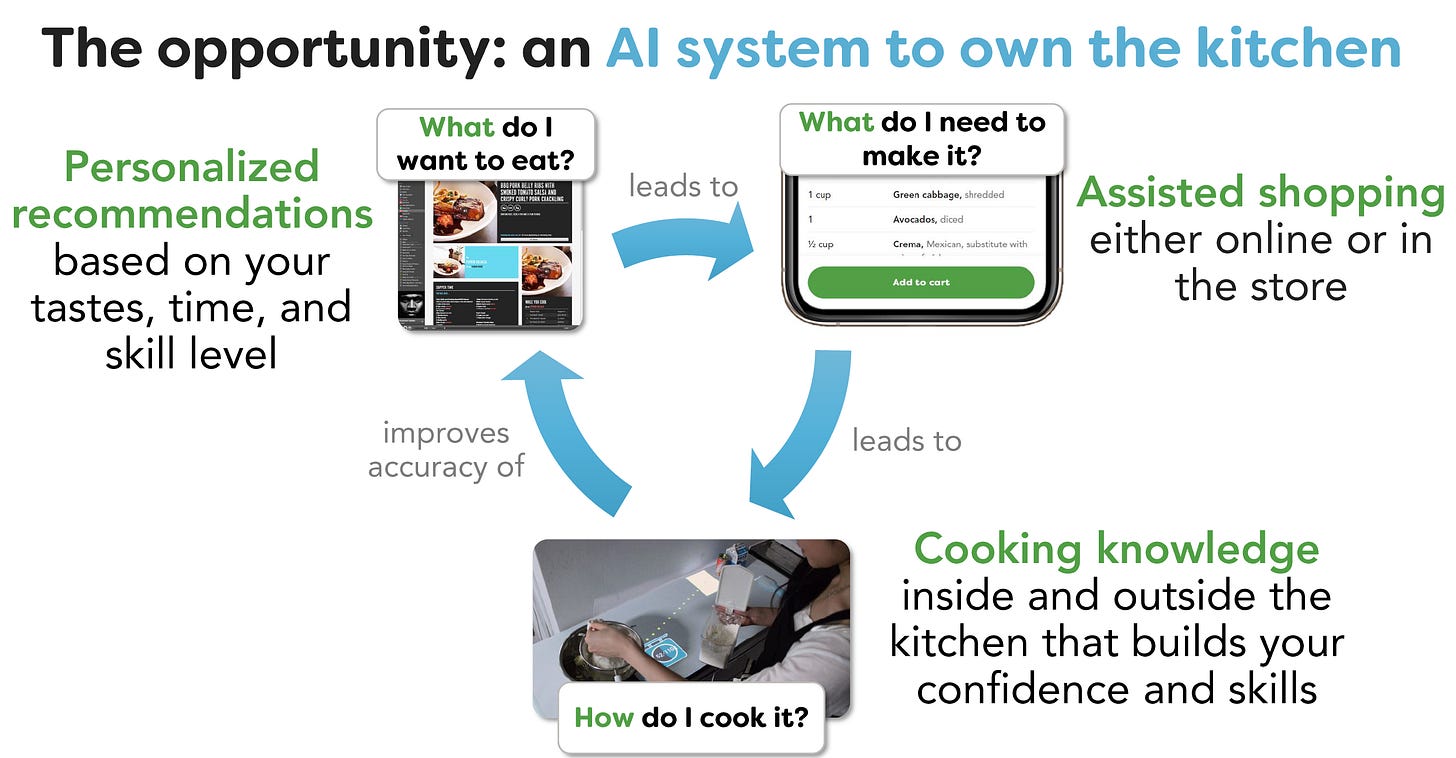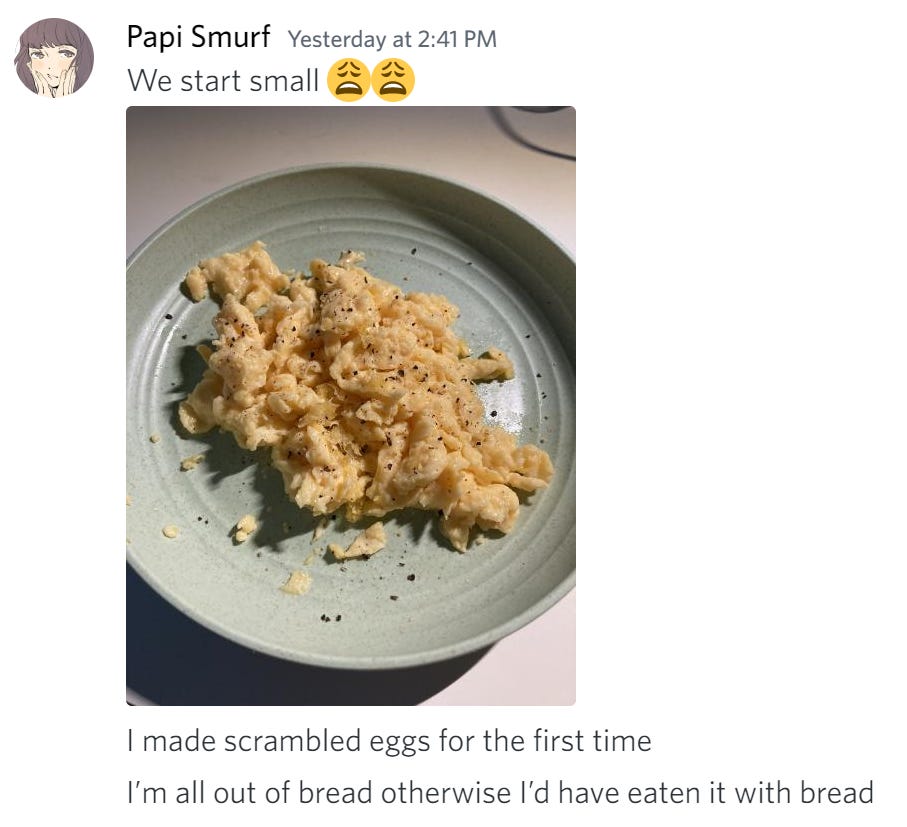The final frontier of consumer tech
A giant opportunity in making cooking easier for a billion people
We’ve been working up to this memo for a while and I’m beyond excited to share it. Here, we lay out the core thesis of Parsnip over the next few years.
Let’s start by setting the stage with a recap of what we’ve established so far:
Cooking is a core life skill with myriad benefits to people and the planet, but we’ve slowly lost it over time.
Food is a giant market—it’s the second biggest expense after rent in the US, and the biggest in most countries. Everyone eats, every day.
Getting better at cooking is hard, and darn near impossible for beginners. We’ve found a wedge to solve that.
There’s more demand than ever for a solution to this problem.
If you’re don’t believe those assumptions, check out those links first. Otherwise, let’s continue!
The huge opportunity in the home kitchen
We won’t bury the lede: the home kitchen is the final frontier of consumer tech.
Despite how many people cook and eat every day, there is very little tech in the home kitchen. Here lies an opportunity to both help billions of people and build an impactful, consequential business.
So, we want to create a magical consumer product for the kitchen—an “AI virtual chef”:
The idea is pretty simple. Imagine that you have a friend who happens to be a professional chef looking over your shoulder, and who helps you:
Figure out what to make for dinner, every day this week
Figure out what ingredients you need to make that food
Learn how to make each meal
But instead of a person, it’s a software system, which can help many more people. It also allows Parsnip to keep helping you, week after week. What you cook this week helps us make better plans for you next week.
But, this system is too huge to build all at once. We need a a much easier first step. We also know that for new products to gain a foothold, they need to be painkillers, not vitamins. Enter the pain of beginner cooks.
The real reason why cooking feels so hard
Try asking anyone of your friends who rarely cooks, why they don’t cook more. I bet you won’t hear “I prefer Soylent and takeout“. Instead, you’ll hear “I’m too lazy…”, “I don’t have time…”. Invariably, it sounds like an excuse with a tinge of guilt.
But for experienced home cooks, making your own food is easier, faster, cheaper, and more delicious than other ways to eat. So, why the disconnect? After trekking through the idea maze for a while, we’ve narrowed it down to two issues—two unexpectedly and surprisingly difficult problems:
In other words, the real difficulty of cooking doesn’t stem from a lack of effort or time, but two hard learning and decision-making problems. Let’s take a look at each of these.
Recipes aren’t instructions, they’re icebergs
Ahh… the humble recipe, the ostensible foundation of cooking. You just buy the ingredients listed, and follow some instructions to produce some food. The directions are straightforward—almost like executing an algorithm, right?
Not quite.
Recipes are surprisingly deceptive. They seem like instructions you can follow, but a more apt analogy is that the recipe is an iceberg and beginner cooks are steaming along on the Titanic.
Like how 90% of icebergs are underwater, most of what’s needed to cook well isn’t in the recipe. In particular, you might not know:
how to dice that onion
how to buy a ripe avocado (spoiler: they aren’t sold ripe)
how to combine flavors in your dish
how to stock your pantry and freezer
how to put out fires in your kitchen
how to avoid salmonella and trichinosis
The current Parsnip app is solving this problem, first for beginners, then for anyone. On Reddit and in other cooking communities, we’ve struck a nerve and found some really excited users. This is the painkiller beginner cooks are looking for. And you can try it too!
Meal planning: an annoying, repeated problem
But, once you’ve learned some of these skills and start getting comfortable in the kitchen, a second annoying problem rears its head: meal planning.
This also seems pretty simple, right? Just figure out what you want to eat, and go get the stuff you need to make it.
Not so fast…
Through a computer science lens, the routine weekly meal planning we do at home looks a lot like an algorithm. Here’s all the data that must go in, and the results that need to come out:
Put another way, you have to start with not just what you want to eat, but what you’re comfortable making, and what ingredients, leftovers, and kitchen tools you have.
And then you need figure out what you’re going to make, any new skills you need to learn, what to use up, what to buy, and where to buy it.
Doing this repeatedly is a pain in the butt!1 But it’s also essential. Experienced cooks don’t rely on recipes—they cook from their pantry. Every cooking culture also makes good use of leftovers. Fried rice recycles leftover rice. Hash browns recycle leftover potatoes. Many recipes on the Internet are ignorant of that food history.
With the technology available today, we can not only help with meal planning—but supercharge it. Wouldn’t you like to see the possibilities for dinner from what’s in your fridge and pantry?
No more wondering what’s for dinner — just swipe left and right, like Tinder, to go through the options of what you can make.
No more wandering the aisles at the grocery store — point your phone at that salmon on sale and see whether you’re in the mood for oven-roasted salmon or salmon stir fry. Instead of annoyance and confusion, shopping becomes a fun scavenger hunt.
Solving the meal planning problem in a magical way creates an amazing experience for making and eating your own food, on a regular basis, at home. But we’re going to need a metric ton of data.
Parsnip’s Master Plan™
So, let’s close the loop. How do these two hard, almost intractable problems of (1) surfacing the iceberg, and (2) making meal planning fun, add up to an AI for the home kitchen? Recall our two main observations:
beginner cooks have a lot of pain
giant opportunity in the home kitchen
From there the logical solution is straightforward (even if not simple).
So, inspired by Tesla’s Master Plan, here’s Parsnip’s Master Plan2:
Build “Duolingo for cooking” to solve the pain for beginners, then expand to advanced cooks.
Discover our users’ skills, tastes, and preferences for cooking and food.
Use that data to solve the meal planning problem and create an AI assistant for the home kitchen.
Put another way, our thesis is that teaching people to cook creates a 0 marginal cost platform that understands consumers in the home kitchen in a way no one else does—because it knows what they like to eat and what they can cook. Then we can solve that hairy meal planning / logistics problem in a magical, 10x better way that no one has before.
In other words, (1) the beginner cook’s pain is a wedge into (2) this big business opportunity3.
Just how big is this opportunity?
At this point you might have another objection: maybe you don’t agree that home cooking is actually a huge market.
Well then, don’t take my word for it. Take Google’s word instead, from Google Trends:

Since Google started collecting data, interest has only gone up. There’s a big temporary shock from COVID, but nothing systematic has changed that suggests it would keep going anywhere but up.
“how to cook” is actually the most popular search term we’ve found that exemplifies this need. But perhaps this trend is just a small niche, and isn’t very mass market. We actually need something (or someone) popular to compare it to. How about this?
So there you have it, ladies and gentlemen. Taylor had a good run, but learning to cook has officially been more popular since 2017.
We have lots of exciting progress to share with you in future posts. But until then, check out a Parsnip user who made scrambled eggs for the first time, ever—and more than that, it only the second time he’s ever cooked. Doesn’t that look yummy?
Even for beginners, recipes just aren’t that important. Learning the how and why, and building up your confidence is what’s important. And once you feel brave enough to conquer the kitchen, the result of being able to make and eat your own food is thrilling:
Until next time! 🚀
It’s actually a multidimensional knapsack problem, known to be among the “hardest” problems to solve optimally in computer science.
Yup, that means there’s a Master Plan Part 2 😁. Want a preview? Let’s talk.
If this all makes sense to you, it’s worth pointing out that it’s only obvious once you know the answer. It’s actually counter-intuitive for a couple reasons: (1) it’s easier for a cooking product to go after intermediate/advanced cooks who are already cooking than beginners who are starting from scratch, and (2) recipes appear to be an essential unit of data for cooking but are mostly unimportant.









this is a super compelling post, i kinda want to see a video of what the parsnip kitchen of the future looks like